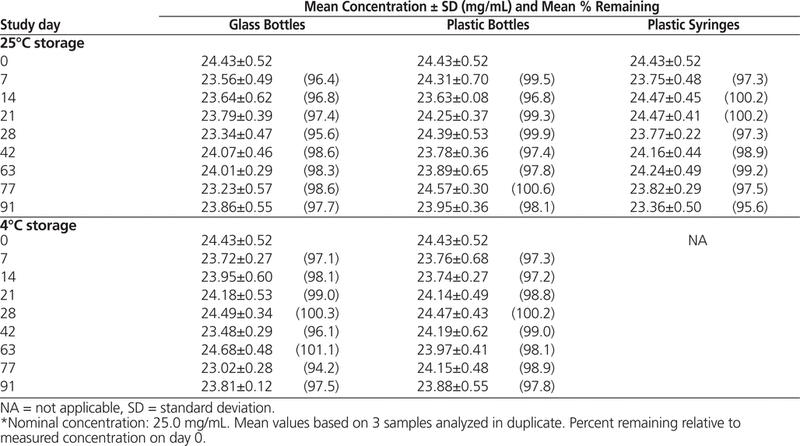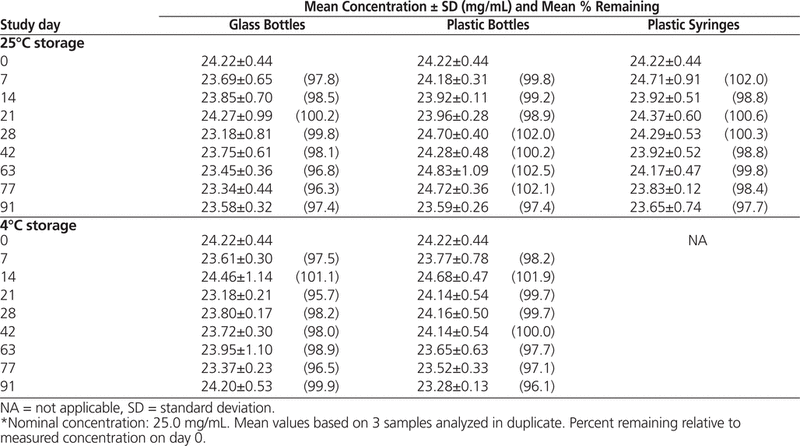
Mary H H Ensom , BS(Pharm), PharmD, FASHP, FCCP, FCSHP , Clinical Pharmacy Specialist , Diane Décarie , BSc , Research Consultant
In Canada, oral liquid formulations of pyridoxine (vitamin B 6 ) must be compounded extemporaneously, and these compounded solutions have limited expiry dates.1 The purpose of the current study was to evaluate whether pyridoxine suspensions (25 mg/mL) are physically and chemically stable in commercially available vehicles, specifically Oral Mix and Oral Mix SF, at 25°C and 4°C for up to 91 days.
Stock pyridoxine suspensions (25 mg/mL) were prepared by diluting pyridoxine hydrochloride 100 mg/mL for injection (Bioniche Pharma, London, Ontario; lot 130503, expiry April 2015) in Oral Mix and Oral Mix SF (Medisca Inc, Plattsburgh, New York; lot 1074/A, expiry February 2015, and lot 1071/A, expiry January 2015, respectively). Each suspension was divided among 6 separate amber glass bottles (Richards Distribution, Richmond, British Columbia), 6 amber plastic (polyethylene terephthalate [PET]) prescription bottles (Richards Distribution), and twenty-five 5-mL oral amber plastic (polypropylene) syringes (PreciseDose Dispenser System, Medisca Inc; lot 46959/C). For each suspension, 3 glass and 3 PET bottles were kept at 25°C, and 3 glass and 3 PET bottles were kept at 4°C. All of the syringes were kept at 25°C.
On days 0, 7, 14, 21, 28, 42, 63, 77, and 91, all samples were examined for changes in colour, taste, odour, and ease of resuspension. On each study day, one aliquot (3 mL) from each bottle and the contents of 3 syringes from each group were collected to determine pH (model 800 pH meter; VWR International, Mississauga, Ontario). Immediately thereafter, 1.5-mL aliquots from each bottle or syringe were transferred to threaded, tight-seal cryogenic polypropylene vials (VWR International; lot 1095990) and stored for a maximum of 100 days at −85°C until analysis by a validated, stability-indicating high-performance liquid chromatography (HPLC) – ultraviolet detection method.
Stock solutions of pyridoxine (25 mg/mL) were prepared from injectable pyridoxine 100 mg/mL in HPLC-grade water (Fisher Scientific, Whitby, Ontario; lot 138367/141099) for construction of a standard curve. The internal standard was prepared from clonidine powder (Sigma-Aldrich, Oakville, Ontario; lot 110M1256V) diluted to 1.0 mg/mL in HPLC-grade methanol (Fisher Scientific; lot 134319).
The HPLC instrumentation (Waters Alliance System model 2690, Waters Corporation, Mississauga, Ontario) consisted of a delivery pump, automatic 200-µL injector, Symmetry C18 4.6 × 100 mm column (Waters Corporation; lot 0203304913884), Symmetry C18 3.9 × 20 mm guard column (Waters Corporation; lot 02813440521), and ultraviolet detector (model 2487, Waters Alliance System) set at 218 nm. The mobile phase consisted of 34% methanol (Fisher Scientific; lot 136336) and 66% 10 mmol/L ammonium formate buffer (Sigma-Aldrich; lot BCBJ-6906V/BCB-L4456V) at pH 5.5 and room temperature. All solvents were HPLC-grade and filtered before use. The flow rate was 0.5 mL/min.
Pyridoxine standard solutions, containing 0.100 mg/mL of internal standard, were prepared in HPLC-grade water to final concentrations of 0.020, 0.030, 0.040, 0.050, 0.060, and 0.070 mg/mL. All standards were passed through GHP (Gelman hydrophilic propylene) 13 mm diameter, 0.45-µm microfilters (Acrodisc, Waters Corporation; lot 1829235) to prevent injection of impurities onto the column.
The range of the 6-point calibration curve (0.020 to 0.070 mg/mL) encompassed the diluted test concentration of pyridoxine (0.050 mg/mL). The curve was generated by least-squares regression of the peak area ratio of pyridoxine to clonidine (the internal standard) and the concentration of each pyridoxine standard. Acceptable limits for the coefficients of variation for precision were defined as less than 10% and acceptable limits for accuracy as greater than 90%.
Accelerated degradation of pyridoxine was achieved as follows. Suspensions of pyridoxine 2.5 mg/mL in Oral Mix and Oral Mix SF were prepared (without internal standard) from the stock solution (100 mg/mL). Aliquots were mixed (v:v) with 1N hydrochloric acid, 1N sodium hydroxide, or 10% hydrogen peroxide, then vortex-mixed and incubated for 18 h at 90°C. The samples were cooled to room temperature and the volume was adjusted with HPLC-grade water to 0.050 mg/mL. Samples were then filtered and injected onto the column. The assay and degradation methods were developed in the authors’ laboratory on the basis of previous work.2,3
Regression analysis showed linearity, with r 2 (coefficient of determination) of 0.997 or above ( n = 4). Intraday and interday coefficients of variation were within acceptable limits (i.e., < 10%): 1.10% and 1.37%, respectively, for the 0.020 mg/mL solution; 0.51% and 0.98%, respectively, for the 0.038 mg/mL solution; 0.39% and 0.40%, respectively, for the 0.048 mg/mL solution, and 0.51% and 0.54%, respectively, for the 0.058 mg/mL solution. Mean intraday and interday accuracy values (± standard deviation) were also within acceptable limits (i.e., > 90%): 98.88% ± 0.60% and 98.63% ± 0.91%, respectively, for the 0.020 mg/mL solution; 99.03% ± 0.89% and 99.02% ± 0.97%, respectively, for the 0.038 mg/mL solution; 99.40% ± 0.16% and 99.39% ± 0.39%, respectively, for the 0.048 mg/mL solution; and 99.41% ± 0.28% and 99.38% ± 0.50%, respectively, for the 0.058 mg/mL solution.
Retention times were 2.91 min for pyridoxine and 4.23 min for clonidine. No interfering peaks were generated by forced degradation of pyridoxine. On average, the pyridoxine peaks decreased with forced degradation by 93% in the Oral Mix vehicle and by 65% in the Oral Mix SF vehicle. Minor noninterfering peaks were observed at 3.20, 4.07, 4.48, and 5.34 min.
The milky white suspensions were easily resuspended and showed no evidence of microbial contamination throughout the study period. The taste of the suspensions became slightly more tart by day 28 (Oral Mix) or by day 63 (Oral Mix SF), but there were no changes in odour. Throughout the study period, the mean pH of the suspensions remained stable, ranging from 3.46 to 3.52 (Oral Mix) and from 3.56 to 3.62 (Oral Mix SF).
HPLC analysis showed that all pyridoxine suspensions maintained at least 94.2% of original concentrations for 91 days (Tables 1 and 2).
Table 1.
Concentration of Pyridoxine in Oral Mix Suspension Vehicle during 91 Days of Storage in Glass Bottles, Plastic Bottles, and Plastic Syringes at 25°C and in Glass and Plastic Bottles at 4°C*
Table 2.
Concentration of Pyridoxine in Oral Mix SF Suspension Vehicle during 91 Days of Storage in Glass Bottles, Plastic Bottles, and Plastic Syringes at 25°C and in Glass and Plastic Bottles at 4°C*
In conclusion, pyridoxine suspensions (25 mg/mL) in Oral Mix and Oral Mix SF suspension vehicles stored in amber glass bottles, plastic bottles, or oral plastic syringes at 25°C or in amber glass or plastic bottles at 4°C can be expected to remain stable for up to 91 days.
1. Pyridoxine. In: AHS Drug Information Pharmacist, editor. Alberta Health Services—Calgary Health Region pharmacy compounding manual. Calgary (AB): Alberta Health Services, Calgary Pharmacy; 2014. p. 187.
2. Ribeiro DO, Pinto DC, Lima LM, Volpato NM, Cabral LM, de Sousa VP. Chemical stability study of vitamins thiamine, riboflavin, pyridoxine and ascorbic acid in parenteral nutrition for neonatal use. Nutr J. 2011;10:47.


3. Ensom MHH, Décarie D. Stability of extemporaneously compounded dexamethasone in glass and plastic bottles and plastic syringes. Can J Hosp Pharm. 2014;67(4):274–9.

Mary Ensom is also a Professor in the Faculty of Pharmaceutical Sciences and Distinguished University Scholar, The University of British Columbia, Vancouver, British Columbia. She is also the Editor of the CJHP . ( Return to Text )
Funding: Funding for this project was provided as an unrestricted educational grant from Medisca Pharmaceutique Inc.
Competing interests: Other than grant support, no competing interests were declared.
Canadian Journal of Hospital Pharmacy , VOLUME 67 , NUMBER 5 , September-October 2014